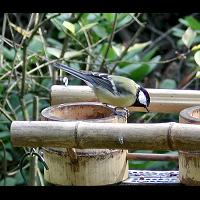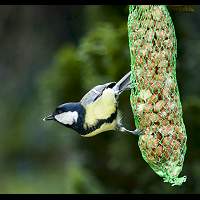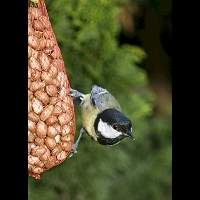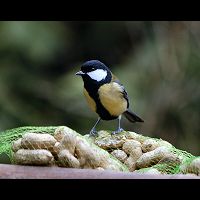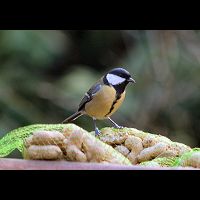[All pictures of garden wildlife on this page are thumbnails. Click on any thumbnail for a large format to be displayed.]
Great Tit (Parus major)
Click![]() here for the bird's sound.
here for the bird's sound.
As the name implies, the Great Tit is the biggest of the Titmice in Europe.
This bird is just a little bigger than the Blue Tit and in the garden is just as common, lively and attractive. It's a bird that starts to sing very early spring (often it's still winter), although it's song isn't very impressive most of the times. Of all the tits this one looks for food on the ground most regularly and in winter it can be found in groups of little birds with among others Blue Tits and Greenfinches. Great Tits are curious and intelligent birds. They will use whatever source of food people willingly or not supply and in that respect resemble the even more nosy Blue Tit very much
One of the first birds discovering you put food in your garden.
With most tits it is impossible to identify males and females by just looking at them. The Great Tit however is the exception. The blue line on the chest of the bird is much bigger in males and runs all the way down. The female's tie is much smaller and often less colourful. It narrows towards the end and the last part exists of just a few smears before the line ever reaching the female's legs. The pictures above show you the differences clearly, but we should add that it sometimes is less obvious than in these two pictures.
Easy to see the difference: the male is on the left and the female to the right.
This bird belongs to the family of Tits or Titmice, in the Usa and Canada called Chickadees, (Paridae). It is very common in our garden and can be seen in Holland all year round. The bird is 5" and weighs 20 grams. It lives in woodlands, parks and gardens mostly. It eats insects, berries, seeds and spiders. Compared to the male, the female is slightly paler, but it usually is very hard to tell the difference. The Great Titmouse makes a nest in a hole. Actually any hole will do, including those in rocks, trees, or those made bij woodpeckers or man. Not less than eight to twelve eggs are produced (usually four to six survive). They are bred for two weeks. It takes the young some 18 days to be able to fly out of the nest.
| Name of this bird in other languages | ||||
| Dutch | German | French | Polish | Scientific |
| Koolmees | Kohlmeise | Mésange charbonnière | Bogatka | Parus major |

© Copyright 1998-2024 gardensafari.net (Hania Berdys)

 English / engels
English / engels  Dutch / nederlands
Dutch / nederlands